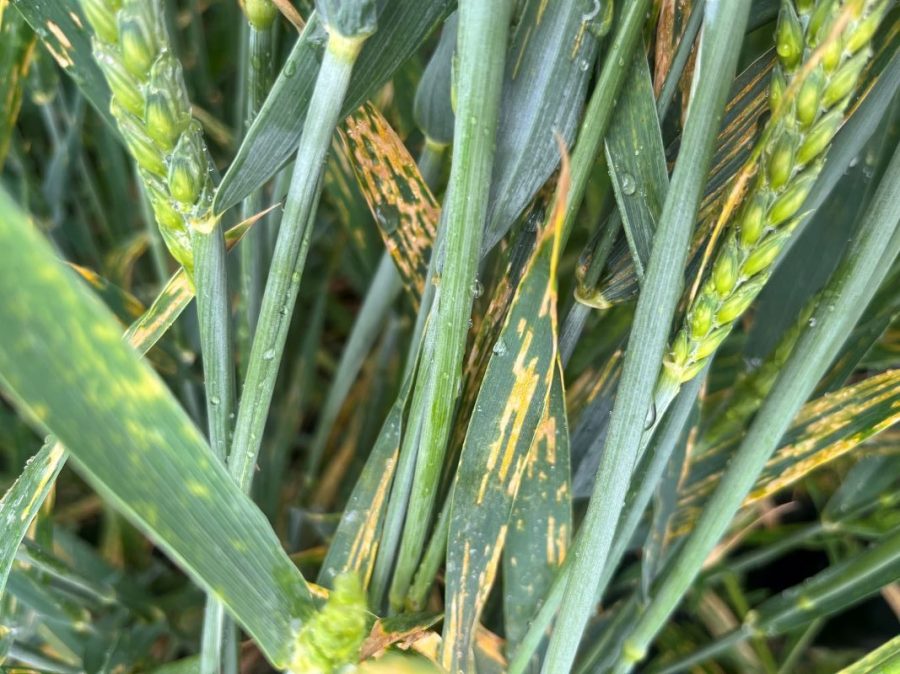A new strain of yellow rust has ripped through crops from Scotland to East Anglia but this time, fungicide efficacy isn’t in question. CPM investigates what’s behind the shift.
“It’s clear that not applying a T0, especially in regions and varieties known to be a risk, is no longer a sustainable course of action.” DR KOSTYA KANYUKA
By Andrew Watts
News that Yr15, the gene discovered in the 1980s that confers broad-spectrum resistance to a genetically diverse group of yellow rust isolates, has been overcome is causing concern and alarm among researchers and agronomists.
Testing of yellow rust isolates collected from infected plants has revealed that the new strain is indeed of UK or European origin, and belongs to the so-called ‘red group’ that’s dominated UK populations in recent years.
Outside of the UK it’s been confirmed in northern France, Belgium, The Netherlands, Czech Republic, Denmark and Sweden, although it’s unclear whether it developed in Great Britain or continental Europe, specifically.
Paul Gosling, AHDB senior crop production specialist, says work led by Niab in collaboration with the John Innes Centre (JIC) in Norwich and the Global Rust Reference Centre (GRRC) in Denmark, is what’s confirmed the strain is of European origin. “This makes the situation distinct from 2011 when a group of races known as ‘Warrior’ arrived in Europe and the UK from the near-Himalayan region of Asia.”
Virulence toward Yr15 is extremely rare – the GRRC reports that of the thousands of yellow rust samples it’s received from more than 50 countries spanning six continents, only a single case from 2002 had shown this virulence.
When it first emerged, however, is unclear. Niab began receiving samples for analysis from previously resistant varieties in November 2024, although it was several months before there were sufficient data to conclude that this was a new strain with the capacity to overcome the Yr15 gene.
“We’ve looked back at the data from AHDB trials in 2024 and there’s nothing to indicate that it was present at low levels,” adds Paul.
The exact number of varieties carrying the Yr15 gene is unknown, with testing so far focussing on those with disease resistance scores of 8 or 9 but that are showing extreme levels of yellow rust infection.
Three of these varieties, Champion, LG Typhoon and KWS Dawsum, are also some of the most popular grown in the UK – collectively these are estimated to account for upwards of 30% of the wheat area in 2025, thus highlighting the significance of this development.
For all of its potency, however, it doesn’t necessarily spell the end of these varieties, suggests Niab’s head of plant pathology, Dr Kostya Kanyuka. “Yr15 gave efficient resistance to yellow rust at the seedling stage, but this is no longer the case. Fortunately, where crops received a suitable fungicide at T0, it appears to have been well controlled.”
REVISED RATINGS
As part of a plan to give growers and advisers the information required to make informed management decisions, the AHDB is preparing to issue revised disease scores for all varieties based on assessments made at sites where this strain of the disease was prevalent. The data is being processed now, and Paul is hopeful that it’ll be published by mid-August.
“It’s perhaps too late to inform variety selection for this autumn, but in combination with other work by Niab and JIC, it should help growers and agronomists to plan accordingly for next season,” he says.
The variety testing undertaken by Niab has since expanded to include all Recommended List and candidate varieties, and several controls. The intention is to identify how frequent Yr15 is amongst current varieties, so to understand the scale of the issue.
Of the 36 varieties tested so far, 12 have been found to carry the Yr15 gene. “It’s clear that not all varieties, including those we know to carry the Yr15 gene, are as badly affected as Champion, Dawsum or Typhoon,” comments Kostya. “This suggests the presence of additional minor genes(s) which have an influence on a variety’s resistance capabilities.”
Some of those lesser affected varieties carrying Yr15 may also carry so-called adult plant resistance gene(s) (APR), which tend to become active only once the plant moves from vegetive growth to flowering, typically at stem extension.
APRs and minor genes don’t provide complete resistance, but rather partial resistance, or reduced susceptibility. Unfortunately, the most badly affected varieties, such as Champion, Dawsum and Typhoon, don’t appear to carry these additional genes for extra protection.
Niab’s testing has so far focussed on establishing the virulence of the latest strain rather than describing any characteristic features such as aggressiveness, latent period or functioning temperature range. These are questions for future studies, adds Kostya.
“We used standard conditions and symptoms appeared on our panel varieties at roughly the same time, and while manifestations were no quicker to appear on Yr15 varieties, the symptoms were more severe than might have otherwise been expected,” he says.
This is perhaps its defining characteristic – on varieties that pose the Yr15 gene, it develops more quickly than those with diverse forms of resistance, but this distinction is unlikely to be sufficient to affect crop protection programmes, believes Kostya.
“It is clear, however, that not applying a T0, especially in those regions and varieties known to be a risk, is no longer a sustainable course of action.”
FUNGICIDE SPEND
With some growers opting to save on a T0 spray, this could partly explain the popularity of Champion, Dawsum and Typhoon, he suggests. “These varieties were resistant for many years and missing a T0, which is of far less significance to performance than either the T1 or T2 spray, represented a low-risk opportunity to save on fungicide costs.”
For Niab agronomist and head of agronomy services, Dr Mark Fletcher, watching the disease develop during the winter and spring this current season has proven highly informative. He says there are now clear differences in the extent to which varieties are affected, while it appears restricted to the North and East.
“It’s most definitely not a typical strain, but until we have more understanding and experience, it’s best being watched carefully. Champion seems to more affected than Dawsum, while Typhoon, which appeared to be the worst affected variety in the early spring, is now suffering less than either Champion or Dawsum,” he explains.
Such observations are of little value this season he admits, but could be invaluable for future years. “A considerable number of the seed crops in production for sowing this autumn and most likely next year are varieties susceptible to the new Yr15-virulent race,” points out Mark.
Add to this the increased risk facing successive wheats and the trend towards reduced tillage systems, and the disease burden next season may well be even greater. “There’ll be a large green bridge to support inoculum carry-over. Assuming it survives the winter and that conditions favour it again next spring, we must be prepared.”
NEW NORMAL
Conditions are certainly trending towards greater disease pressure, he believes. This is because winters are becoming milder and summers generally wetter, albeit 2025 bucks this trend. Add in a greater focus among growers on crops which have historically been the most profitable, such as winter wheat, plus a preference for direct drilling, and the risk that strains virulent on Yr15 pose is only likely to increase.
The rapid emergence and spread of this strain may have caught growers and agronomists off-guard, adds Mark, but the dry conditions through spring meant there were sufficient spray days available to get on top of it.
“If spray timings were well-timed then crops stayed clean, but you only had to be slightly late, especially with Champion, to have issues. It could be recovered, but at a cost,” he says.
“Solatenol or other chemistry with strong activity against yellow rust such as prothioconazole will do well. Our work at Morley investigating T1 choices other than tebuconazole suggests there are several alternatives that perform well.
“The focus, however, will continue to be septoria so we’re looking at products or combinations of products that deliver broad-spectrum control,” explains Mark.
It’s not a shortage of effective fungicides that poses a crop protection dilemma, rather the difficulty in deciding the optimum programme to deliver the protection required, he suggests. “We have the material to protect crops but given the economic pressures facing growers, the challenge is to make a judgement that proves to be correct,” concludes Mark.
This article was taken from the latest issue of CPM. Read the article in full here.
For more articles like this, subscribe here.
Sign up for Crop Production Magazine’s FREE e-newsletter here.




